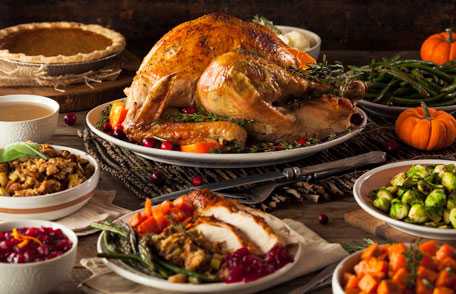Food Safety Tips for your Holiday Turkey
 Food handling errors and inadequate cooking are the most common problems that lead to poultry-associated foodborne disease outbreaks in the United States.1 Follow these four food safety tips to help you safely prepare your next holiday turkey meal.
Food handling errors and inadequate cooking are the most common problems that lead to poultry-associated foodborne disease outbreaks in the United States.1 Follow these four food safety tips to help you safely prepare your next holiday turkey meal.
1. Safely Thaw Your Turkey
Thaw turkeys in the refrigerator, in a sink of cold water that is changed every 30 minutes, or in the microwave. Never thaw your turkey by leaving it out on the counter. A frozen turkey is safe indefinitely, but a thawing turkey must defrost at a safe temperature. When the turkey is left out at room temperature for more than two hours, its temperature becomes unsafe as it moves into the danger zone between 40°F and 140°F, where bacteria can grow rapidly.
2. Safely Handle Your Turkey
Bacteria from raw poultry can contaminate anything that it touches. Follow the four steps to food safety – cook, clean, chill, and separate – to prevent the spread of bacteria to your food and family.
Take Care with Leftovers
Clostridium perfringens are bacteria that grows in cooked foods left at room temperature. It is the second most common bacterial cause of food poisoning. Symptoms can include vomiting and abdominal cramps within 6 to 24 hours after eating.
- Outbreaks occur most often in November and December.2
- Meat and poultry accounted for 92% of outbreaks with an identified single food source.
Refrigerate leftovers at 40°F or colder as soon as possible and within two hours of preparation to prevent food poisoning.

Use a food thermometer to check for a safe internal temperature.
3. Safely Stuff Your Turkey
Cook stuffing in a casserole dish to make sure it is thoroughly cooked. If you stuff the turkey, do so just before cooking. Use a food thermometer to make sure the stuffing’s center reaches 165°F. Bacteria can survive in stuffing that has not reached 165°F and possibly cause food poisoning. If the stuffing is inside a whole turkey, take the bird out of the oven and let it stand 20 minutes before removing the stuffing. Learn more about how to safely prepare stuffing.
4. Safely Cook Your Turkey
Set the oven temperature to at least 325°F. Place the completely thawed turkey with the breast side up in a roasting pan that is 2 to 2-1/2 inches deep. Cooking times will vary depending on the weight of the turkey. To make sure the turkey has reached a safe internal temperature of 165°F, check by inserting a food thermometer into the center of the stuffing and the thickest portions of the breast, thigh, and wing joint. Let the turkey stand 20 minutes before removing all stuffing from the cavity and carving the meat. Learn more about safe minimum cooking temperatures and how to use and calibrate a food thermometer for turkey and other foods.
References
- Chai SJ, Cole D, Nisler A, and Mahon BE. Poultry: the most common food in outbreaks with known pathogens, United Sates, 1998-2012. Epidemiol Infect. 2016 Oct;1-10.
- Grass JE, Gould LH, and Mahon BE. Epidemiology of foodborne disease outbreaks caused by Clostridium perfringens, United States, 1998-2010. Foodborne Pathog Dis. 2013 Feb;10(2):131-6.
More Information
More Information
- CDC Food Safety
- CDC’s Gear Up for Food Safety [311 KB]
- FoodSafety.gov: Turkey
- CDC’s Clostridium perfringens web page
- Steps to Follow Before, During, and After Cooking Your Thanksgiving Turkey | En Español; FoodSafety.gov
- Holiday Resources; USDA, Food Safety and Inspection Service
- Let’s Talk Turkey—A Consumer Guide to Safely Roasting a Turkey | En Español; USDA, Food Safety and Inspection Service
- USDA Meat & Poultry Hotline: 1-888-MPHotline (1-888-674-6854)
- Consumer information: Chat live with a food safety specialist at USDA’s AskKaren.gov, 10 a.m.—4 p.m. ET, Monday through Friday, in English or Spanish (www.PregunteleaKaren.gov). Web-based automated response system available 24/7.
- Page last reviewed: November 18, 2016
- Page last updated: November 18, 2016
- Content source:
- National Center for Emerging and Zoonotic Infectious Diseases, Division of Foodborne, Waterborne, and Environmental Diseases
- Page maintained by: Office of the Associate Director for Communication, Digital Media Branch, Division of Public Affairs




 ShareCompartir
ShareCompartir